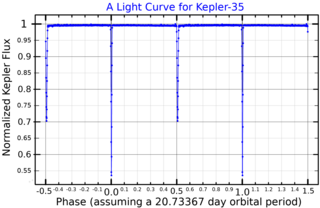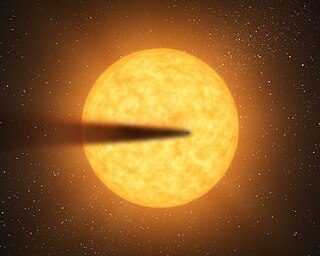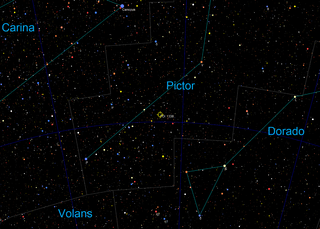
A B-type subdwarf (sdB) is a kind of subdwarf star with spectral type B. They differ from the typical subdwarf by being much hotter and brighter. They are situated at the "extreme horizontal branch" of the Hertzsprung–Russell diagram. Masses of these stars are around 0.5 solar masses, and they contain only about 1% hydrogen, with the rest being helium. Their radius is from 0.15 to 0.25 solar radii, and their surface temperature is from 20,000 to 40,000 K.

A circumbinary planet is a planet that orbits two stars instead of one. The two stars orbit each other in a binary system, while the planet typically orbits farther from the center of the system than either of the two stars. In contrast, circumstellar planets in a binary system have stable orbits around one of the two stars, closer in than the orbital distance of the other star. Studies in 2013 showed that there is a strong hint that a circumbinary planet and its stars originate from a single disk.
The Kepler Input Catalog is a publicly searchable database of roughly 13.2 million targets used for the Kepler Spectral Classification Program (SCP) and the Kepler space telescope.

Kepler-16b is a Saturn-mass exoplanet consisting of half gas and half rock and ice. It orbits a binary star, Kepler-16, with a period of 229 days. "[It] is the first confirmed, unambiguous example of a circumbinary planet – a planet orbiting not one, but two stars," said Josh Carter of the Center for Astrophysics | Harvard & Smithsonian, one of the discovery team.

Kepler-16 is an eclipsing binary star system in the constellation of Cygnus that was targeted by the Kepler spacecraft. Both stars are smaller than the Sun; the primary, Kepler-16A, is a K-type main-sequence star and the secondary, Kepler-16B, is an M-type red dwarf. They are separated by 0.22 AU, and complete an orbit around a common center of mass every 41 days. The system is host to one known extrasolar planet in circumbinary orbit: the Saturn-sized Kepler-16b.

Kepler-34 is an eclipsing binary star system in the constellation of Cygnus. Both stars have roughly the same mass as the Sun and, like the Sun, both are spectral class G. They are separated by 0.22 AU, and complete an eccentric (e=0.5) orbit around a common center of mass every 27 days.

Kepler-35 is a binary star system in the constellation of Cygnus. These stars, called Kepler-35A and Kepler-35B have masses of 89% and 81% solar masses respectively, and both are assumed to be of spectral class G. They are separated by 0.176 AU, and complete an eccentric orbit around a common center of mass every 20.73 days.

Planet Hunters is a citizen science project to find exoplanets using human eyes. It does this by having users analyze data from the NASA Kepler space telescope and the NASA Transiting Exoplanet Survey Satellite. It was launched by a team led by Debra Fischer at Yale University, as part of the Zooniverse project.
Kepler-47 is a binary star system in the constellation Cygnus located about 3,420 light-years away from Earth. The stars have three exoplanets, all of which orbit both stars at the same time, making this a circumbinary system. The first two planets announced are designated Kepler-47b, and Kepler-47c, and the third, later discovery is Kepler-47d. Kepler-47 is the first circumbinary multi-planet system discovered by the Kepler mission. The outermost of the planets is a gas giant orbiting within the habitable zone of the stars. Because most stars are binary, the discovery that multi-planet systems can form in such a system has impacted previous theories of planetary formation.

Kepler-47c is an exoplanet orbiting the binary star system Kepler-47, the outermost of three such planets discovered by NASA's Kepler spacecraft. The system, also involving two other exoplanets, is located about 3,400 light-years away.
Kepler-38 is a binary star system in the constellation Lyra. These stars, called Kepler-38A and Kepler-38B have masses of 95% and 25% solar masses respectively. The brighter star is spectral class G while the secondary has spectral class M. They are separated by 0.147 AU, and complete an eccentric orbit around a common center of mass every 18.8 days.
Dirk Terrell is an American astronomer and space artist who is the Director of the Computer and Software Sciences section in the Planetary Science Directorate of the Space Science and Engineering division of the Southwest Research Institute. He is a Fellow and former President of the International Association of Astronomical Artists. He holds a Bachelor of Science degree in physics from Clemson University and a Ph.D. in astrophysics from the University of Florida.

Kepler-47b is an exoplanet orbiting the binary star system Kepler-47, the innermost of three such planets discovered by NASA's Kepler spacecraft. The system, also involving two other exoplanets, is located about 3,400 light-years away.
Kepler-453b is a transiting circumbinary exoplanet in the binary-star system Kepler-453. It orbits the binary system in the habitable zone every 240.5 days. The orbit of the planet is inclined relative to the binary orbit therefore precession of the orbit leads to it spending most of its time in a non-transiting configuration. By the time the TESS and PLATO spacecraft are available for follow up observations it will no longer be transiting.

Kepler-1647b is a circumbinary exoplanet that orbits the binary star system Kepler-1647, located 3,700 light-years (1,100 pc) from Earth in the constellation Cygnus. It was announced on June 13, 2016, in San Diego at a meeting of the American Astronomical Society. It was detected using the transit method, when it caused the dimming of the primary star, and then again of the secondary star blended with the primary star eclipse. The first transit of the planet was identified in 2012, but at the time the single event was not enough to rule out contamination, or confirm it as a planet. It was discovered by the analysis of the Kepler light-curve, which showed the planet in transit.

Kepler-1520b, is a confirmed exoplanet orbiting the K-type main sequence star Kepler-1520. It is located about 2,020 light-years away from Earth in the constellation of Cygnus. The exoplanet was found by using the transit method, in which the dimming effect that a planet causes as it crosses in front of its star is measured. The planet was previously proposed in 2012 when reports of its host star recorded drops in its luminosity varying from 0.2% to 1.3%, which indicated a possible planetary companion rapidly disintegrating. In 2015, the planetary nature of the cause of the dips was finally verified. It is expected to disintegrate in about 40–400 million years.

In astronomy, a disrupted planet is a planet or exoplanet or, perhaps on a somewhat smaller scale, a planetary-mass object, planetesimal, moon, exomoon or asteroid that has been disrupted or destroyed by a nearby or passing astronomical body or object such as a star. Necroplanetology is the related study of such a process.

Heartbeat stars are pulsating variable binary star systems in eccentric orbits with vibrations caused by tidal forces. The name "heartbeat" comes from the similarity of the light curve of the star with what a heartbeat looks like through an electrocardiogram if their brightness was mapped over time. Many heartbeat stars have been discovered with the Kepler Space Telescope.

TOI-1338 is a binary star system located in the constellation Pictor, about 1,320 light-years from Earth. It is orbited by two known circumbinary planets, TOI-1338 b, discovered by the Transiting Exoplanet Survey Satellite (TESS) and BEBOP-1c, discovered by the Binaries Escorted By Orbiting Planets project.















